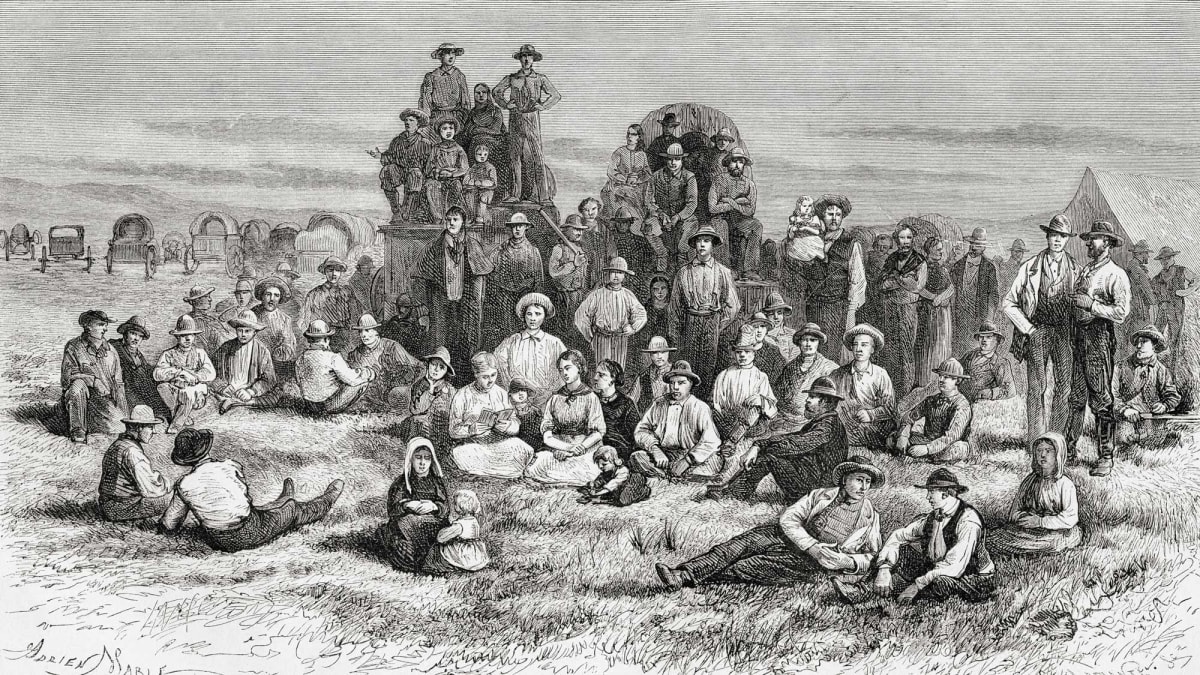
In early 1850, Church leaders advised emigrants that pioneer companies would travel on a new route on the south side of the Platte River. By taking this new route they avoided some river crossings on the north side which had proved dangerous because of high water in the previous year. They also expected to receive additional military protection on a new army supply road. This was a factor in their decision because they wanted to avoid conflict with the Plains Indians, who had been agitated during the 1849 California gold rush. The 200-mile long army road connected "Old Fort Kearny," located 50 miles below Kanesville on the Missouri River, to "New Fort Kearny" following the south side of the Platte River to the west.
The fifth company to depart from Kanesville was led by Edward Hunter. They were the first company to use donations gathered under the Perpetual Emigration Fund (PEF) to travel to Utah. Created in 1849, the PEF was a revolving loan fund established to help needy Saints emigrate. Bishop Hunter used $5,000 of the PEF donations received that winter to outfit the company. They traveled 18 miles south on the east bank of the Missouri River to the Bethlehem Ferry (across the river from present-day Plattsmouth, Nebraska), where they were delayed for two weeks while looking for reasonably priced oxen. While waiting here, they watched the remainder of the Mormon companies cross the river and start west.
Near the end of June they began crossing the river. By July 1, they had all crossed. They went a few miles from the ferry to 12-Mile Creek where they washed, cooked, and prepared the company for a real start. On 5 July they left their camp and followed the Plattsmouth-Fort Kearny trail south. They were at the rear of all the emigrant companies en route for Utah. There were 261 people and 67 wagons (some sources place the number of wagons at 42) in the company.
After crossing Weeping Water Creek on June 18 they followed a new trail west where they connected with the northward-arching new military road, which became known as the Ox-Bow Trail. After leaving Salt Creek they turned west on a cutoff trail near present-day Swedesburg, Nebraska. All of the companies except Andrus used this cutoff, which passed near present-day David City and Bellwood, Nebraska. This cutoff trail, which bypassed the Cottonwood/Wahoo Creek drainage, saved them 12 miles. On this shortcut route, they arrived at the Platte at a point about 20 miles west of the regular route taken earlier by Andrus.
They then followed the south bank of the Platte River a hundred miles west past Grand Island, where they joined with the Oregon Trail coming north from Missouri. At this juncture they continued 15 more miles to New Fort Kearny, which they reached on July 24. The army reserved grazing rights and companies weren't permitted to camp within a mile of the fort. So they camped there for two days while they lightened the wagons. They then continued up the south side of the river until they reached the Upper Crossing of the South Platte (located about three miles west of present-day Brule, Nebraska). They crossed and from here they followed a long dry ridge for twenty miles to Ash Hollow on the south bank of the North Platte. They arrived there on 9 August. They continued on and reached Fort Laramie on 25 August. They traveled through the Black Hills, crossed the Platte for the last time, and reached Independence Rock and Devil's Gate on September 8. Throughout the journey there had been two "divisions of Fifty" in the Hunter company-one headed by Lewis Wight and the other by Edwin D. Woolley. Often the two divisions were separated by as much as South Pass, and the leading Fifty (Woolley's) overtook Wilford Woodruff's company two days later. Woolley's Fifty reached Fort Bridger on September 25 and arrived in Salt Lake on October 2.
Wight's Fifty with Captain Hunter were days behind them and didn't get to Salt Lake until October 13-14, having a difficult time traveling through snow that was hub deep. Four people died in Hunter's company-only one a victim of cholera. The company also transported almost 5,000 pounds of freight destined for Brigham Young and Newel K. Whitney. In keeping with the PEF plan, the Hunter company sold its livestock upon reaching the valley and the money realized from the sale was put back in the fund to be used the following year.